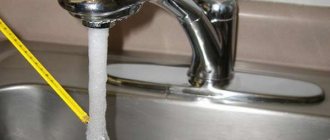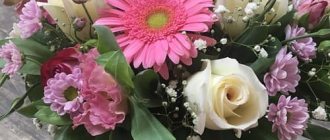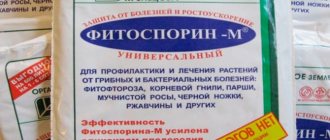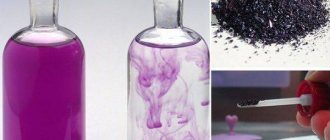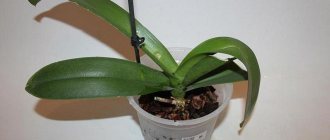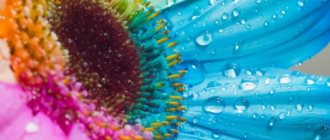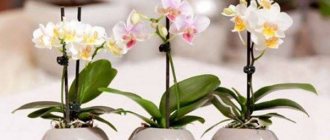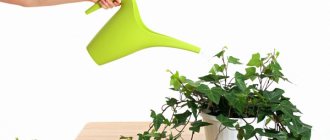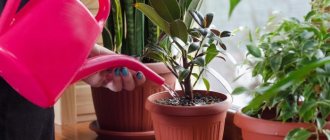Houseplants are like children, each with their own character and mood. One likes to be frequently turned around its axis, the other, on the contrary, try it, move it from place to place, and the bud will fall off without ever blooming.
But from excess or lack of moisture, green pets are capricious in different ways: either restrainedly drooping their leaves, or desperately dying.
Any gardener knows that it is not worth watering flowers with immediately collected tap water; it contains harmful substances used by our domestic industry for disinfection. Therefore, you should pour water into the container and let it sit for several hours or days. It is not advisable to water with cold water, because... plants experience shock; heat-loving indoor plants may die due to root rot. It is necessary to take at room temperature or 1-2 degrees higher.
It is also not recommended to water with boiled water - it is “dead” and does not have dissolved air or microelements. There will be no harm, but no benefit either. As for rain or melt water, it has always been considered optimal for irrigation. But now it is necessary to make allowances for the state of the environment. If you live far from industrial production or major highways, precipitation water can be beneficial for plants. In megacities with such water, it is better not to take risks. The same applies to river or well water.
In today's environmental conditions, it is preferable to water indoor flowers with artesian drinking water, but not with mineral water.
Experienced gardeners advise using aquarium water for irrigation, and if you take its bottom layer, you can combine watering with fertilizing, since sludge has always been a good fertilizer. But it is worth remembering that you will get beautiful, juicy leaves on the flowers, but they may refuse to bloom - and there should be a measure of fertilizer. After all, if there are a lot of fish and little vegetation in the aquarium, there will be excess nitrogen in the water.
When talking about water, it is necessary to seriously focus on water hardness. Hardness is the capacity of calcium and magnesium salts per unit volume of water, expressed in mEq/l.
Define:
- soft – up to 3 mEq/l
- medium hardness – 3-6 mEq/l
- hard – more than 6 mEq/l
- very hard – over 9 mEq/l
Watering with hard water has harmful effects on plants, namely:
- the accumulation of calcium and magnesium salts changes the acidity of the soil towards an alkaline reaction - camellias, azaleas, ferns that prefer acidified soil die;
- difficulty in normal absorption of essential nutrients by plants;
- reduction of resistance to non-infectious diseases - spotting, dry and wet rot.
Water for watering indoor plants
Houseplants are like children, each with their own character and mood.
One likes to be frequently turned around an axis, the other, on the contrary, try it, move it from place to place, and the bud will fall off without ever blooming. But from excess or lack of moisture, green pets are capricious in different ways: either restrainedly drooping their leaves, or desperately dying. Any gardener knows that it is not worth watering flowers with immediately collected tap water; it contains harmful substances used by our domestic industry for disinfection. Therefore, you should pour water into the container and let it sit for several hours or days. It is not advisable to water with cold water, because... plants experience shock; heat-loving indoor plants may die due to root rot. It is necessary to take at room temperature or 1-2 degrees higher.
It is also not recommended to water with boiled water - it is “dead” and does not have dissolved air or microelements. There will be no harm, but no benefit either. As for rain or melt water, it has always been considered optimal for irrigation. But now it is necessary to make allowances for the state of the environment. If you live far from industrial production or major highways, precipitation water can be beneficial for plants. In megacities with such water, it is better not to take risks. The same applies to river or well water.
In today's environmental conditions, it is preferable to water indoor flowers with artesian drinking water, but not with mineral water.
Experienced gardeners advise using aquarium water for irrigation, and if you take its bottom layer, you can combine watering with fertilizing, since sludge has always been a good fertilizer. But it is worth remembering that you will get beautiful, juicy leaves on the flowers, but they may refuse to bloom - and there should be a measure of fertilizer. After all, if there are a lot of fish and little vegetation in the aquarium, there will be excess nitrogen in the water.
When talking about water, it is necessary to seriously focus on water hardness. Hardness is the capacity of calcium and magnesium salts per unit volume of water, expressed in mEq/l.
Define:
- soft – up to 3 mEq/l
- medium hardness – 3-6 mEq/l
- hard – more than 6 mEq/l
- very hard – over 9 mEq/l
Watering with hard water has harmful effects on plants, namely:
- the accumulation of calcium and magnesium salts changes the acidity of the soil towards an alkaline reaction - camellias, azaleas, ferns that prefer acidified soil die;
- difficulty in normal absorption of essential nutrients by plants;
- reduction of resistance to non-infectious diseases - spotting, dry and wet rot.
Need for mitigation
It should be carried out to:
Remove metallic or bitter taste.
Eliminate the possibility of sedimentation so that the water can be bottled or used for the preparation of alcoholic beverages, juices, and other food industry products.
Protect household appliances from scale: excess salt will certainly be deposited on the walls and heating elements of boilers, washing machines, kettles and will first reduce their performance (and therefore increase energy costs for heating by 15-20%), and then cause a breakdown.
Minimize the consumption of powder and other detergents containing surfactants. It is with surfactants that unwanted impurities will interact, binding them and reducing their effectiveness.
Get rid of plaque on the surfaces of taps and mixers, toilet cistern, bidet body and other plumbing fixtures, as well as tiles. Deposits not only look unsightly and are difficult to wipe off, but also gradually destroy even hard materials.
Prevent clogging of industrial systems - scale reduces the throughput and heat transfer coefficient of pipes, gradually clogging them, which results in an increase in fuel consumption for equipment maintenance.
And, most importantly, softening must be carried out to protect your body from the negative effects of excess salts.
How to soften water for irrigation
There are many ways. The simplest ones for home use are the following:
- Add charcoal to the settled water at the rate of 3 g per 1 liter of water (oak and chestnut wood cannot be used to produce charcoal);
- A fabric bag filled with 100 g of fresh peat is placed in a 10-liter container for a day - then you can even wash your hair with this water.
If the home plumbing system is equipped with a filter for purifying drinking water, the problem of hardness is eliminated; filtration usually removes calcium and magnesium salts from the water.
There is also a chemical method of softening water; quite often this method uses oxalic acid, but there is a serious caveat - you need to know exactly the hardness of the water - otherwise the slightest imbalance will cause an undesirable reaction in indoor plants. A digital tester for determining hardness can be purchased at a flower shop or online store.
Adding peat
You can reduce the hardness of water for irrigation using peat. For this you will need 100 g. fresh peat and 10 l. water. It is with these proportions that the result will be more significant.
So, we put the peat in a linen bag, and then put it in a container with water for the whole day. If you don’t have time to wait, and you need water right now, then make your own peat filter and pass a portion of fresh water through it.
To make a filter, take a flower pot (preferably large) with a drainage hole. Then place a linen napkin at the bottom of the pot (the cloth should be rough), and pour loose peat on top of it. Fill the flower pot to the top. After this, place the container with peat above the empty bucket.
Fill another bucket with water and pass it through a peat filter. All the water that flows into the bucket from the filter will be suitable for irrigation. By the way, adding peat will help not only soften the water, but also acidify it.
Amount of water for irrigation
When watering indoor flowers, you should never forget about the amount of water. You need to figure out what type of watering your plant requires - abundant, moderate or sparse, and remember - in summer the soil dries out faster, therefore, the plant needs more intensive moisture than in winter.
Abundant - the soil should always remain moist, but the top layer should dry out between waterings. Spathiphyllum and monstera require abundant watering.
Moderate - the top layer of soil should dry out 2-3 cm between waterings. This is how ficus, dracaena, orchids, and aloe are watered.
Rare - the soil should dry out by about 2/3, but not dry out completely. Cacti and other succulents require infrequent watering.
Finally, there are two restrictions for watering:
- the soil should not be too wet even for moisture-loving indoor flowers, except for a few minutes after receiving moisture;
- the soil in the pot should not dry out too much, even for drought-resistant plants, with the exception of cactus.
Gift from heaven
When you are faced with a dilemma whether it is possible to water indoor flowers with boiled water, or whether it is better to use tap water, you end up with a choice of two evils. Of course, it is best to choose less, but there is no definite answer here, it all depends on the specific plant and its needs.
Therefore, you can simply choose the third option. Rainwater can become this way. You need to collect it when it rains for the second day in a row. This rule applies only to urban conditions, since on the first day all the harmful substances that got into the clouds fall out.
We water the flowers correctly!
We water the flowers correctly!
Just as a person is unable to live without water and food, the life of representatives of the plant world is unthinkable without watering. The need for water varies among different plants and is determined by their characteristics: the structure of the stems and leaves, the power of the root system, etc. Water for watering flowers must be neutral in its acid-base state and contain as few harmful impurities as possible (salts of heavy metals, chlorine, fluorine, etc.). The acidity of the water (pH) is of great importance. The pH value is a measure of the amount of free hydrogen ions contained in water. Increased or decreased acidity can not only harm the health of the plant, but also lead to its death. The pH of drinking water ranges from 6 to 9. And the pH of water for irrigation should be in the range of 5.8 - 6.2. It is convenient to control the pH of water using the “electronic pH meter KL-009(I)A” device, which can be purchased in our store. You can use it easily, just do not forget to calibrate it monthly to improve the accuracy of measurements. You can also purchase the calibration solution from us. In addition to an electronic device for measuring pH, you can use a liquid ph test. Measurement range from 4.0 to 8.5. The test is highly reliable and low priced. By adding two drops of the test to a test tube with the test liquid and comparing the resulting color of the solution with the color chart attached to the test, you will instantly get the result and be able to adjust the acid-base state of the water for irrigation.
Read a more detailed article - What is ph
Filter
Many homes have water filters that you use to purify the liquid for yourself. They are also perfect for preparing water for irrigation. In addition to softening to normal levels, the filter excludes petroleum products, chlorine and heavy metals.
Which filter to use is up to you. But a small jug with a large volume will be slow, inefficient and uneconomical, because the insert cassette will quickly become unusable. To get out of this situation, you can purchase two jugs: one for your own household needs, the other for flowers.
The best solution to the problem is a flow filter. It has several stages of cleaning, and it can handle large volumes without much difficulty.
What is the best water to use for irrigation?
Filtered and settled
Drinking water for the needs of the population is disinfected with chlorine; it contains hardness salts. Watering potted crops with it is dangerous: salts coat the roots with a coating that prevents them from absorbing moisture. The plant is suffering. Therefore, before watering, the liquid is passed through flow filters.
Watering indoor flowers
Precisely calculated doses of chlorine are safe for people. But it is destructive for a home greenhouse - it is a strong oxidizing agent, and the roots get burned.
To neutralize the effect of a toxic substance, place tap water in an open container for a day, then water and spray the plants. An added benefit is that it becomes the same temperature as the potting soil.
Important! Plants do not tolerate cold showers or moisture. The optimal temperature is room temperature.
Watering with settled water
Is it possible to water flowers with mineral water?
Mineral water is a rich natural source of salts and microelements. Contains calcium and magnesium needed by flowers. It would seem like an ideal watering option. But according to agricultural technicians, this cannot be done. Salts in high concentrations make it hard. The soil in flower vases quickly becomes salty. Bicarbonate and alkalis depress plantings. Pets wither, buds fall off
Begonias are tolerant of mineral water, but the gas is released from it before use.
Distilled water
This is a liquid obtained in distillers, without natural salts.
Gardeners are not unanimous in their opinion whether it is possible to water indoor flowers with distilled water.
It is neutral in acidity. It's good for plants. But if you constantly water indoor crops with it, it will wash nutrients from the soil and deplete it. In a poor substrate, flowers do not develop properly. But this is an alternative to hard water.
Important! Distilled water does not harm plants if mineral fertilizers are dissolved in it.
How to soften water at home for watering flowers
Rain, melt, and river life-giving moisture is ideal for ornamental crops. But collecting it, especially in the city, is difficult. Then they look for ways to soften water at home for watering indoor flowers.
Several methods are used:
- stand for 24 hours;
- add 100 grams of peat per 10 liters of water;
- To soften, add 1 tbsp. l. citric acid per 10 liters of water;
- use hot tap water (it is softened in boiler rooms). Cool before watering;
- They make a water purification filter from thick fabric, cotton wool, or activated carbon. They put everything in several layers and wrap it around the faucet. Apply low pressure and pour into the dishes.
If the hardness is more than 10 mg eq per 1 liter, gardeners know what to do and how to soften the water for watering indoor plants. They determine the indicator in laboratories, or purchase a pocket tester - it gives the result in 3 seconds.
Cause of the problem
The main reason for increased water hardness is magnesium and calcium salts, which cause permanent, or carbonate, hardness. When the soil pH is more than 7 units, iron, copper, manganese, phosphorus and other elements form insoluble compounds that are not absorbed by the roots. As a result, plants do not receive enough nutrients.
To protect your crops from death, use simple ways to reduce water hardness.
Is it possible to water flowers with beer?
Flower fans on forums discuss not only what kind of water is suitable for watering indoor plants, but also what else to irrigate their pets with.
Gardeners know about the benefits of yeast - they are used as a top dressing.
Yeasts are fungi. In the ground they awaken microorganisms that actively process organic matter. A lot of nitrogen and potassium are released, which are necessary for green spaces.
The soil in a flower pot is quickly depleted, and yeast comes in handy here. They are found in abundance in beer. Without even doubting whether it is possible to water flowers with beer, flower growers practice this method.
The beer method is beneficial only if the drink is “alive”. Preservatives and stabilizers, which preserve bottled beer for up to six months, are harmful to plantings.
The indoor rose is considered a beer “admirer”. Money trees, dracaenas, and spurges are tolerant of such moisture.
Important! Before watering, “live” beer is diluted with water in the ratio: 1 part intoxicating drink to 10 parts liquid.
Filter options
How to soften drinking water becomes clear when studying the household filter market. Enterprises sell cleaning devices in a variety of designs: there are options for washing a separate faucet, and there are various attachments for existing faucets. Systems differ in filtration speed.
Therefore, in addition to analyzing turbidity, hardness and composition, it is important to determine the approximate consumption. Installed household meters will help solve this problem. If they are not there, you will have to contact engineering companies where specialists know how to work using special formulas.
The easiest filter to clean is a “jug”. It is a compact softener made in the form of a plastic vessel.
Filtration is carried out through the arrangement of such components as:
Water usually enters through the first layer of carbon and ends up in the bowl already purified. Activated carbon removes almost all organic matter. Zeolite eliminates the content of ammonia and other “volatile” components, and the resin softens it.
The main advantage of jugs is their small size and ability to move. Availability is also a significant plus.
The disadvantage is the average quality of purification, but here everything is connected with the condition of the water supply.
Cartridge-type softener filters are available on the market in flow-through varieties. They are sold as faucet attachments or on the main line. A simple option is a desktop one, which consists of a replaceable cartridge enclosed in a plastic flask.
The device has a tap through which clean water flows. On the other side, the flow filter has a hose connected to the mixer. Flowers somewhat reduce the pressure from the water supply. Therefore, if it is already insignificant, they are not recommended for use.
Filter nozzles for faucets are the same technology, but with a reduced distance to the device. There are options available with internal or external threads. The obvious advantage of the products is their compactness. In addition, the installation of nozzles can be done without a plumber.
The filter device under the sink is essentially also a flow channel. The method of cleansing through a device is the most radical, but it requires free space for installation. The connection is made directly to the pipes and then to the mixer.
The design consists of several plastic flasks, which include various components. Water passes through the entire system and is disinfected from minerals and organic matter, softened and iron-free.
Is it possible to water indoor flowers with water from an aquarium?
An aquarium is a closed ecosystem. Microorganisms and bacteria live in it. Dissolved minerals, vitamins, humic acids. The liquid is warm and oxygenated. Inhabitants are fish and snails, which add urea.
Water from an aquarium is no longer just life-giving moisture, but an organic substrate.
Regarding its use, the opinions of flower growers are completely opposite. Some consider aquarium substrate an elixir for moisture-loving species. They notice the lush flowering and lush greenery of the potted inhabitants. Others are not seeing fantastic growth.
Even specialists are not enthusiastic about the method. The undoubted benefits are considered:
- temperature of the irrigation liquid;
- savings on fertilizing;
- oxygen saturation;
- no chlorine.
But it cannot be called clean, even despite the filters. There will be no harm to plants from aquarium liquid if you moisten the soil periodically - once a month.
Important! Before watering, the aquarium substance is aerated by blowing atmospheric air through the water column with an aerator.
Aquarium - organic substrate
In the garden
When planting vegetables in open ground beds, rain will come to your aid. However, precipitation does not always replace watering. Be sure to check to what depth the soil is wet after rain. Long, calm rain is good for vegetables, but a heavy, but short downpour most often will not give a good result, it will only refresh the plants.
For some plants, in a favorable year, if precipitation occurs periodically, natural watering is sufficient. Such unpretentious crops include pumpkins, zucchini, squash, peas, and potatoes. In hot and dry weather, you will have to water them too, so as not to lose the harvest.
Other vegetables require watering to a greater or lesser extent. Its frequency depends not only on the crop’s requirements for moisture, but also on the specific conditions of your site. Light, sandy and sandy loam soils require more water and it drains away faster.
Article on the topic
Stop the invasion. How to protect your garden and garden from pests?
Is it possible to water indoor flowers with serum?
People are returning to nature, everything natural: fabrics, food, drinks. This slogan was transferred to home flora. Now the question is no longer which liquid to choose for irrigation. They take natural products, without pesticides and chemicals. Whey came under the gun. And for good reason.
The whey is acidic. Useful substances: amino acids, trace elements, phosphorus, potassium, lactic bacteria. An invaluable fertilizer and pest suppressant. An undiluted product will damage the flora and disrupt the soil balance. Suitable ten times mixed with liquid. This is the base solution.
- Add 0.5 kg of sugar per 10 liters and a pinch of yeast to the whey solution. Fill the cut grass.
- Dissolve iodine in diluted whey (10 drops per 10 l), add ash.
To water under the roots, dilute 1 part fertilizer in 10 parts of liquid. For spraying, take 1 liter of solution for 3 liters of water.
Important! In a dormant state, plants are not fed with whey.
Serum for watering a home greenhouse
LiveInternetLiveInternet
—Tags
—Links
-News
-Music
-Always at hand
—Categories
- Interesting links (351)
- (0)
- Beads and bead mania (534)
- Keyrings (11)
- Bead embroidery (3)
- Knitting with beads (8)
- Trees (26)
- Necklace and earrings (278)
- Rings, bracelets (26)
- MK beads, weaving techniques, books (69)
- Product diagrams and magazines (52)
- Beaded flowers (101)
- Eggs and balls (5)
- Parenting (903)
- Everything for studying (176)
- Nursery rhymes, songs, sayings (19)
- For children. Miscellaneous (20)
- Games and how to make them (50)
- Books, fairy tales, other (15)
- Speech therapy, speech development (146)
- Psychology (91)
- Developmental and training programs (451)
- Tests (12)
- Your baby can do it. Crafts (60)
- Knitting (13572)
- ON-LINE knitting (34)
- Sirloin knitting (31)
- Appliques, decorations and all sorts of little things (115)
- Boleros, vests, sleeveless vests (1066)
- Pants, shorts (20)
- Mittens, gloves, mitts (20)
- Transformable things (33)
- Attention to detail (360)
- Collars (38)
- Inserts (ideas for use) (61)
- Knitted shoes (25)
- Knitting for children (109)
- Knitting for comfort (15)
- Knitting motifs (108)
- Knitting with fur (21)
- Knitting with combi fabric (113)
- Knitted accessories (4)
- Knitted toys (16)
- Gaiters, leggings, tights, socks, etc. (25)
- Jackets (689)
- Jacquard knitting (37)
- Animals (and sewing) (19)
- Magazines and Books (1782)
- Ideas without description (56)
- Irish lace (556)
- Border, edge trim, straps, etc. (377)
- Pattern collection (1395)
- Sets and suits (149)
- Round yoke in knitting (65)
- Ribbon lace (22)
- Men (328)
- Capes, ponchos, shawls, stoles (338)
- Coat, chazuble, cardigan (686)
- Pets (18)
- Dresses, tunics, sundresses (1510)
- Beach beauty. Swimwear, etc.. (137)
- Pullovers, jackets, jumpers. (4037)
- Romanian, Bruges lace (27)
- Websites for knitting and other handicrafts (337)
- Napkins, tablecloths. (471)
- Bags (108)
- Knitting techniques, knitting individual elements (158)
- Tops, T-shirts, blouses. summer models (2070)
- Knitting lessons (83)
- Symbols, translation (39)
- Crochet and knitting flowers (161)
- Hats, caps, berets, headbands (375)
- Scarf, bactus, shawl (203)
- Skirts (337)
- Japanese openwork, schemes (728)
- Glamour, fashion, stars (2)
- For a summer residence (504)
- Ideas for the garden (250)
- Spicy herbs (14)
- Advice from the “experienced” (226)
- For a diary (980)
- Virtual communication (29)
- Comments, thanks. (189)
- Flash watches, epigraphs. (13)
- Animation, clipart decorations for decoration (79)
- Everything for Liru and about Liru (188)
- For the holidays (92)
- Transition buttons (211)
- Personal (46)
- Wishes (6)
- Dividers (10)
- Frames (70)
- Emoticons and other nonsense (7)
- Backgrounds, themes and schemes (143)
- Home cinema - films, videos, cartoons (158)
- Cartoons on-line or download (101)
- Film library (30)
- Interior. Let's create beauty? (232)
- Fashion and advice from stylists. Color combinations (93)
- Leather and fur (347)
- All about leather and suede. (53)
- Fur Kingdom (96)
- Flowers made of leather and fur (192)
- Indoor plants. My silent friends. (289)
- Queen of Flowers - Her Majesty ORCHID (137)
- Computer. (435)
- PC for "dummies". All-round education. (92)
- Programs for needlework (29)
- Programs and “needs” for PC (225)
- Photoshop and Co. What, where and how? (124)
- Beauty and health (3427)
- make-up (71)
- Gymnastics and fitness (259)
- Diagnostics (87)
- Diets, weight loss and everything connected with them (571)
- Yoga (7)
- DIY cosmetics (75)
- Cosmetology (260)
- Beautiful body (36)
- Beautiful hair and eyelashes (78)
- Medicinal dishes, drinks and recipes (608)
- Treatment of ARVI, sore throat, flu, colds (164)
- We are being treated. Therapeutic advice and prevention (687)
- Manicure (29)
- Massage and self-massage (154)
- Medical reference book (33)
- Traditional medicine for a hundred ailments (416)
- Rejuvenating (324)
- Cleansing the body (251)
- Psychology and psychosomatics (49)
- Miscellaneous (32)
- Makeup secrets (6)
- Taking care of your nails (42)
- Hair care - hairstyles (184)
- Foot care (6)
- Learn to dance (20)
- Cookbook (11076)
- "Kitchen" tips (2)
- "Strange" recipes (14)
- Dishes in pots (12)
- Seafood dishes (21)
- Fish dishes (511)
- Offal dishes (120)
- Cottage cheese dishes (131)
- In the microwave and multicooker. (56)
- Jam, jam, confiture. (257)
- Video recipes (28)
- Second life of bread (16)
- Main courses and side dishes (441)
- Unsweetened pastries (1000)
- Sweet pastries (1071)
- Desserts (264)
- Children's kitchen (52)
- Homemade MacDonalds and all sorts of junk (50)
- Fried (86)
- Snacks, sandwiches (389)
- Jellied (8)
- Casseroles (176)
- From ready-made dough and lavash (145)
- From eggs and more (30)
- Do-it-yourself sour milk (83)
- Chinese cuisine (19)
- Canning, marinades, preparations (988)
- I love Korean cuisine! (And Thai, Chinese) (579)
- Cooking Tricks (15)
- Cuisine of the world (78)
- Kitchen Tips (14)
- Manti, dumplings, dumplings (31)
- Meat eaters are happy (1099)
- Quickly, from the series “guests on the doorstep” (84)
- Drinks (269)
- Vegetables and fruits, other products. (450)
- First courses (101)
- Pizza, shawarma, rolls (559)
- Nutritional supplements (7)
- Collections of various dishes (197)
- Useful properties of food products - on the farm (97)
- Spices (74)
- Cooking websites (59)
- Salatomania (1525)
- Sweets (234)
- Sauces, mayonnaise, seasonings, adjika. (511)
- Sushi and rolls (71)
- We make the dough ourselves (167)
- Cakes and pastries (642)
- Decorating dishes (95)
- Deep fat (1)
- Mysticism, magic, miraculous, transcendental, unknown.. (1848)
- All about damage (38)
- Horoscopes, fortune telling, dream books (19)
- Magic tips (434)
- Money magic (274)
- Prayers and spells (620)
- Amulets, amulets. (313)
- I know and learn (256)
- Psychic practitioners (35)
- Psychological-esoteric (260)
- Rituals, ceremonies, self-correction, attitudes (533)
- Simoron (288)
- Man and woman (39)
- Multimedia - music, video. (36)
- Unassembled (9)
- Leisure and travel (9)
- Utilities (913)
- Wisdom (167)
- Tests (1)
- Our smaller brothers (6)
- Money. How to earn and how to save. (33)
- Housekeeping - everything on the shelves (48)
- Life is -almost- without chemicals. (108)
- Online earnings and online shopping (11)
- It will come in handy. (91)
- Economic tips.1000 “HOW. » (435)
- Feng Shui (6)
- Note to the hostess (333)
- Politics (55)
- Poetic. For the soul. (277)
- Cool! (130)
- DIY repairs (41)
- Handicrafts (1290)
- Embroidery (75)
- Ribbon Embroidery (18)
- Ganutel (1)
- Decoupage (4)
- MK-master classes (hand-made) (365)
- Soap making (21)
- Alterations - second life of old things, up-grade (346)
- Newspaper weaving (55)
- Weaving. (3)
- Crafts (93)
- Crafts from plastic bottles and dishes (7)
- Jewelry and decor (183)
- Cold porcelain (123)
- Flowers made of fabric and paper. in different techniques (200)
- Sewing (1187)
- Blouse, blazer, jacket and everything “on top” (180)
- Pants, capris, shorts. (31)
- All sorts of things (22)
- Decorating clothes (102)
- Ideas without descriptions (11)
- Modeling and design (140)
- Dresses (409)
- Miscellaneous (13)
- Bags (43)
- Sewing techniques (48)
- Sewing curtains (115)
- We sew for children (12)
- Skirts (85)
Is it possible to water flowers with tea leaves and tea?
Chemical analysis of tea shows: tannins, potassium, manganese, iron.
The debate among forum members about the benefits of tea leaves as a means of fertilizer does not subside.
- the acidity of the substrate increases;
- air penetrates better into the soil;
- compost is activated;
- clay soils are loosened;
- Mulching retains moisture.
- flower growers have a sufficient selection of universal fertilizers to use dubious ones;
- scented additives upset the soil balance;
- the sweet drink breeds pests: fungus gnats, midges;
- moldy tea leaves introduce bacteria and fungi into the ground;
- the soil turns sour.
An easy way to check if your water is suitable for watering your plants
Hello everyone who follows the florist's notes section.
Today I will share with you the results of my experiment to determine the appropriate water for watering my favorite plants.
I was inspired to get confused about this topic by streptocarpus, which, more than other plants, despise dissolved mineral salts in water, do not like high Ph and suffer intensely from these factors.
Streptocarpus variety Spin Art
So some gardeners complained to me that they could not make friends with these plants.
It seems that the soil is suitable and the lighting is good, but for some reason the streptocarpus are dying.
For some reason, we don’t pay any attention to irrigation water, but this is very important. I think this is what causes problems for some Streptocarpus breeders.
Not only streptocarpus react painfully to inappropriate water, but other flowers too.
Violets will never show you what they are capable of and what caps they can bloom in if you water them with hard tap water.
Begonias can rot from improper water.
Prevention measures
The main preventive measure is watering the soil with melted water, rainwater or pre-treatment of the liquid or soil to acidify it, as described above. It is recommended to pay attention to other practical tips:
Thus, hard water is not suitable for watering almost all crops. Moreover, the greater the rigidity, the worse the effect of such a liquid on plant tissue. If it is known that in the region this indicator is too high (the entire middle zone, the Volga region, the Black Earth Region, the Southern Urals and South-Western Siberia), it is necessary to take special measures - otherwise the harvest may significantly decrease.
Source
